Classification of Heritage Residential Building Stock and Defining Sustainable Retrofitting Scenarios in Khedivial Cairo
Abstract
1. Introduction
2. Literature Review
2.1. Building Typology and Classification
2.2. Heritage Value Types from a Retrofitting Perspective
3. Materials and Methods
3.1. Case Study Selection
3.1.1. Historical Value
3.1.2. Symbolic Value
3.1.3. Urban Value
3.1.4. Architectural Value
3.1.5. Functional Value
3.2. Case study Description
3.3. Heritage Residential Buildings Inventory and Mapping
3.4. Classification of the Building Stock and Reference Buildings Selection
- 1.
- Number of floors
- 2.
- Number of adjoining walls (boundaries)
- 3.
- Building construction types
- 4.
- Floor area
- 5.
- Building volume
- 6.
- Reference buildings
3.5. Interviews with Egyptian Experts/Academics
3.6. Case Study (Building) Selection and Description
4. Results
4.1. Database and Documentation
4.2. Classification of the Building Stock and Reference Buildings
4.3. Classification of the Heritage Grades
4.4. Retrofitting Scenarios Based on Cultural Values
4.4.1. Heritage Grade A
4.4.2. Heritage Grade B
4.4.3. Heritage Grade C
4.4.4. Analysis of the Case Study (Building)
4.5. A Detailed Catalogue of the Reference Buildings
5. Discussion
5.1. Main Findings and Recommendations
- Phase one provides a database of the case study area, Khedivial Cairo, and includes geometric, construction, building age and heritage data, etc. The database was created based on data by CAPMAS in 2017 and recently created GIS maps by the authors, keeping in mind that there is no map available at this moment for these heritage buildings.
- Phase two classifies the heritage building stock in Khedivial Cairo based on the following steps: number of floors, number of adjoining walls, building construction type and materials, floor area building volume, and reference buildings. All the buildings are located in hot dry climate, and most of these buildings were built in the nineteenth century, see Figure 9d, and are apartment buildings, see Figure 9c, accordingly, climate zone, construction age, and building size were excluded from the proposed methodology. The outcome of this classification were twelve subclasses, and accordingly twelve reference buildings were extracted. Additionally, determining the building volume for each building class and highlighting the largest building classes in terms of weighted share of stock that significantly impact energy demand. It is noted that it is not necessary for a building class that has a large number of buildings to have the same percentage of weight/volume. In this study, the Class 4.2 is the least one in terms of percentage of buildings, as it has only four buildings, but it is the largest class in terms of weighted share of stock. While Class 5.1 has the largest class in terms of percentage of buildings, but it comes in fourth order in terms of largest weighted share of stock.
- Phase three clarifies obscure interpretations of the local conservation law through interviews with the relevant experts. Accordingly, the heritage building stock was classified once again based on heritage Grades (A, B, and C), and the actual numbers of these heritage grades were defined in each extracted building class.
- Phase four classifies the heritage Grades (A, B, and C) in terms of heritage value locations (urban district, building exterior, and interior) and types (visual, physical, and spatial). Accordingly, a checklist of the retrofitting scenarios allowed in each heritage grade was proposed. The proposed checklist is a matrix based on the following three dimensions: heritage value locations, types, and heritage building grades. This checklist was proposed based on the EFFESUS methodology, taking into consideration the local context of the study area. For its validation, a real retrofitted heritage building was analyzed by comparing a list of retrofitting scenarios, and it was implemented in this case study with the proposed checklist.
- Phase five provides a catalogue of reference buildings represented in twelve buildings, the parameters for creating energy models of the selected buildings, and a list of sustainable retrofitting scenarios were defined.
5.2. Strengths and Limitations of the Study
5.3. Study Implications and Future Research
6. Conclusions
Author Contributions
Funding
Institutional Review Board Statement
Informed Consent Statement
Data Availability Statement
Acknowledgments
Conflicts of Interest
References
- International Energy Agency (IEA). World Energy Balances: Overview. International Energy Agency IEA. 2018. Available online: https://www.iea.org/reports/world-energy-balances-overview#africa (accessed on 30 November 2020).
- Pérez-Lombard, L.; José, O.; Christine, P. A review on buildings energy consumption information. Energy Build. 2008, 40, 394–398. [Google Scholar] [CrossRef]
- Ahmed, S.A. Financial Aspect and Practicability of Converting Existing Buildings to nZEB Case Study in Cairo, Egypt. IOP Conf. Ser. Earth Environ. Sci. 2019, 397, 012021. [Google Scholar] [CrossRef]
- Ballarini, I.; Corrado, V. A new methodology for assessing the energy consumption of building stock. Energies 2017, 10, 1102. [Google Scholar] [CrossRef]
- De Vasconcelos, A.B.; Pinheiro, M.D.; Manso, A.; Cabaço, A. A Portuguese approach to define reference buildings for cost-optimal methodologies. Appl. Energy 2015, 140, 316–328. [Google Scholar] [CrossRef]
- Lee, J.; Shepley, M.M.; Choi, J. Exploring the effects of a building retrofit to improve energy performance and sustainability: A case study of Korean public buildings. J. Build. Eng. 2019, 25, 100822. [Google Scholar] [CrossRef]
- Fouseki, K.; Newton, D.; Murillo Camacho, K.S.; Nandi, S.; Koukou, T. Energy Efficiency, Thermal Comfort, and Heritage Conservation in Residential Historic Buildings as Dynamic and Systemic Socio-Cultural Practices. Atmosphere 2020, 11, 604. [Google Scholar] [CrossRef]
- Loli, A.; Bertolin, C. Towards zero-emission refurbishment of historic buildings: A literature review. Buildings 2018, 8, 22. [Google Scholar] [CrossRef]
- Bottero, M.; D’Alpaos, C.; Oppio, A. Ranking of Adaptive Reuse Strategies for Abandoned Industrial Heritage in Vulnerable Contexts: A Multiple Criteria Decision Aiding Approach. Sustainability 2019, 11, 785. [Google Scholar] [CrossRef]
- Lidelöw, S.; Örn, T.; Luciani, A.; Rizzo, A. Energy-efficiency measures for heritage buildings: A literature review. Sustain. Cities Soc. 2019, 45, 231–242. [Google Scholar] [CrossRef]
- Roberti, F.; Oberegger, U.F.; Lucchi, E.; Gasparella, A. Energy retrofit and conservation of built heritage using multi-objective optimization: Demonstration on a medieval building. In Proceedings of the Building Simulation Applications, Bolzano, Italy, 4–6 February 2015. [Google Scholar]
- Martínez-Molina, A.; Tort-Ausina, I.; Cho, S.; Vivancos, J.L. Energy efficiency and thermal comfort in historic buildings: A review. Renew. Sustain. Energy Rev. 2016, 61, 70–85. [Google Scholar] [CrossRef]
- Egyptian Electricity Holding Company (EEHC). Annual Report 2018/2019; Ministery of Electricity & Renewable Energy: Cairo, Egypt, 2020. [Google Scholar]
- World Bank Open Data. CO2 Emissions (Metric Tons per Capita)—Egypt, Arab Rep. 2020. Available online: https://data.worldbank.org (accessed on 30 November 2020).
- Morsy, M.; Fahmy, M.; Elshakour, H.A.; Belal, A.M. Effect of thermal insulation on building thermal comfort and energy consumption in Egypt. J. Adv. Res. Appl. Mech. 2018, 43, 8–19. [Google Scholar]
- Fahmy, M.; Mahmoud, S.; Elwy, I.; Mahmoud, H. A Review and Insights for Eleven Years of Urban Microclimate Research Towards a New Egyptian ERA of Low Carbon, Comfortable and Energy-Efficient Housing Typologies. Atmosphere 2020, 11, 236. [Google Scholar] [CrossRef]
- Albadry, S.; Khaled, T.; Hani, S. Achieving net zero-energy buildings through retrofitting existing residential buildings using PV panels. Energy Procedia 2017, 115, 195–204. [Google Scholar] [CrossRef]
- Hanna, G.B. Sustainable energy potential in the Egyptian residential sector. J. Environ. Sci. Eng. 2013, 2, 374–382. [Google Scholar]
- Theodoridou, I.; Papadopoulos, A.M.; Hegger, M. A typological classification of the Greek residential building stock. Energy Build. 2011, 43, 2779–2787. [Google Scholar] [CrossRef]
- Central Agency for Public Mobilization and Statistics (CAPMAS). Egypt Population, Housing and Establishment Census 2017; CAPMAS: Cairo, Egypt, 2017. [Google Scholar]
- National Organization for Urban Harmony in Egypt (NOUH). Inventory Lists of Distinguished Buildings. 2008. Available online: http://urbanharmony.org/ar_cities.asp (accessed on 30 November 2020).
- Hassan, N.; Khalifa, M.A.; Hamhaber, J. Adaptive Reuse as a Revitalization Tool: The Case of Downtown Cairo Post Relocation of Governmental Buildings to the New Administrative Capital. In Architecture and Urbanism: A Smart Outlook; Springer: Cham, Switzerland, 2020; pp. 289–301. [Google Scholar]
- Mercedes, V.; Galila, E.; Ralph, B.L.R. Discovering Downtown Cairo Architecture and Stories; Jovis: Berlin, Germany, 2015. [Google Scholar]
- Fracastoro, G.V.; Serraino, M. A methodology for assessing the energy performance of large scale building stocks and possible applications. Energy Build. 2011, 43, 844–852. [Google Scholar] [CrossRef]
- Dascalaki, E.G.; Droutsa, K.G.; Balaras, C.A.; Kontoyiannidis, S. Building typologies as a tool for assessing the energy performance of residential buildings–A case study for the Hellenic building stock. Energy Build. 2011, 43, 3400–3409. [Google Scholar] [CrossRef]
- Filogamo, L.; Peri, G.; Rizzo, G.; Giaccone, A. On the classification of large residential buildings stocks by sample typologies for energy planning purposes. Appl. Energy 2014, 135, 825–835. [Google Scholar] [CrossRef]
- Ballarini, I.; Corgnati, S.P.; Corrado, V.; Talà, N. Improving energy modeling of large building stock through the development of archetype buildings. In Proceedings of the 12th Conference of the International Building Performance Simulation Association (IBPSA), Sydney, Australia, 14–16 November 2011. [Google Scholar]
- Ballarini, I.; Corgnati, S.P.; Corrado, V. Use of reference buildings to assess the energy saving potentials of the residential building stock. Energy Policy 2014, 68, 273–284. [Google Scholar] [CrossRef]
- Loga, T.; Stein, B.; Diefenbach, N. TABULA building typologies in 20 European countries—Making energy-related features of residential building stocks comparable. Energy Build. 2016, 132, 4–12. [Google Scholar] [CrossRef]
- International Energy Agency-Energy Conservation in Buildings and Community Systems (IEA-ECBCS). Annex31 Energy-Related Environmental Impact of Buildings; Canada Mortage and Housing Corporation: Ottawa, ON, Canada, 2004. [Google Scholar]
- Sartori, I.; Wachenfeldt, B.J.; Hestnes, A.G. Energy demand in the Norwegian building stock: Scenarios on potential reduction. Energy Policy 2009, 37, 1614–1627. [Google Scholar] [CrossRef]
- Caputo, P.; Costa, G.; Ferrari, S. A supporting method for defining energy strategies in the building sector at urban scale. Energy Policy 2013, 55, 261–270. [Google Scholar] [CrossRef]
- Mata, É.; Kalagasidis, A.S.; Johnsson, F. Energy usage and technical potential for energy saving measures in the Swedish residential building stock. Energy Build. 2013, 56, 100–108. [Google Scholar] [CrossRef]
- Mata, É.; Kalagasidis, A.S.; Johnsson, F. Building-stock aggregation through archetype buildings: France, Germany, Spain and the UK. Build. Environ. 2014, 81, 270–282. [Google Scholar] [CrossRef]
- Broström, T.; Donarelli, A.; Berg, F. For the categorisation of historic buildings to determine energy saving. AGATHÓN Int. J. Archit. Art Design 2017, 1, 135–142. [Google Scholar]
- Broström, T.; Eriksson, P.; Liu, L.; Rohdin, P.; Ståhl, F.; Moshfegh, B. A Method to Assess the Potential for and Consequences of Energy Retrofits in Swedish Historic Buildings. Hist. Environ. Policy Pract. 2014, 5, 150–166. [Google Scholar] [CrossRef]
- Moshfegh, B.; Rohdin, P.; Milic, V.; Donarelli, A.; Eriksson, P.; Broström, T. A method to assess the potential for and consequences of energy retrofits in Swedish historic districts. In Proceedings of the 3rd International Conference on Energy Efficiency in Historic Buildings (EEHB2018), Visby, Sweden, 23–27 September 2018. [Google Scholar]
- Eriksson, P.; Milić, V.; Brostrom, T. Balancing preservation and energy efficiency in building stocks. Int. J. Build. Pathol. Adapt. 2019, 38, 356–373. [Google Scholar] [CrossRef]
- Raslan, E.; Donarelli, A.; De Angelis, E. Categorization of the heritage building stock in Cairo for the energy planning purposes: A method and the typical buildings. In Proceedings of the 3rd International Conference on Energy Efficiency in Historic Buildings (EEHB2018), Visby, Sweden, 26–27 September 2018. [Google Scholar]
- Carter, R.W.; Bramley, R. Defining Heritage Values and Significance for Improved Resource Management: An application to Australian tourism. Int. J. Herit. Stud. 2002, 8, 175–199. [Google Scholar] [CrossRef]
- Veysel, A. Value, Meaning and Understanding of Heritage: Perception and Interpretation of Local Communities in Turkey; University College London: London, UK, 2015. [Google Scholar]
- Uğural, M.N.; Heyecan, G.; Mariusz, U. Determinants of the Turnover Intention of Construction Professionals: A Mediation Analysis. Sustainability 2020, 12, 954. [Google Scholar] [CrossRef]
- Pujol, L.; Champion, E. Evaluating presence in cultural heritage projects. Int. J. Herit. Stud. 2012, 18, 83–102. [Google Scholar] [CrossRef]
- Abedi, M.; Soltanzadeh, H. The Interaction between Tradition and Modernity in Contemporary Architecture of Persian Gulf States: Case Study of United Arab Emirates. Int. J. Res. Humanit. Soc. Stud. 2014, 1, 24–34. [Google Scholar]
- Egyptian Law No. 144 of 2006. Regulation of the Demolition of Unthreatened Buildings and Constructions and the Conservation of the Architectural Heritage (Translated from Arabic); Egyptian Law: Egypt, Cairo, 2006. [Google Scholar]
- Egyptian Law No. 119 of 2008. Building Law (Translated from Arabic); Egyptian Law: Egypt, Cairo, 2008. [Google Scholar]
- ElShabrawy, H.O.; Khodeir, L. Heritage management: Investigating current practices in sustainable retrofitting of built heritage, methodologies, tools and approaches. In Proceedings of the 1st International Conference on Cities’ Identity through Architecture & Arts, Cairo, Egypt, 11–13 May 2017. [Google Scholar]
- UNESCO World Heritage Centre. Operational Guidelines for the Implementation of the World Heritage Convention; UNESCO: Paris, France, 1999. [Google Scholar]
- Hermann, C.; Rodwell, D. Heritage significance assessments to evaluate retrofit impacts: From heritage values to character-defining elements in praxis. In How To Assess Built Heritage? Lublin University of Technology: Lublin, Poland, 2015; pp. 169–190. [Google Scholar]
- Eriksson, P.; Hermann, C.; Hrabovszky-Horváth, S.; Rodwell, D. EFFESUS Methodology for Assessing the Impacts of Energy-Related Retrofit Measures on Heritage Significance. Hist. Environ. Policy Pract. 2014, 5, 132–149. [Google Scholar] [CrossRef]
- Pickard, R. Funding the Architectural Heritage: A Guide to Policies and Examples; Council of Europe: Strasbourg, France, 2009. [Google Scholar]
- Eriksson, P. Character defining elements: Relations between heritage regulations, user perspectives and energy saving objectives. In Proceedings of the 3rd International Conference on Energy Efficiency in Historic Buildings (EEHB2018), Visby, Sweden, 26–27 September 2018. [Google Scholar]
- Rashed, M.; Mostafa, M. Architectural Identity in Contemporary Cairo; Politecnico Di Milano: Milan, Italy, 2015. [Google Scholar]
- Hawas, S.Z. Khedivian Cairo: Identification and Documentation of Urban-Architecture in Downtown Cairo, 1th ed.; Architectural Design Center: Cairo, Egypt, 2002. [Google Scholar]
- UNESCO World Heritage Centre-Management of World Heritage Sites in Egypt. Urban Regeneration Project for Historic Cairo (URHC); UNESCO: Paris, France, 2014. [Google Scholar]
- National Organization for Urban Harmony (NOUH). The Foundations and Guidelines of Urban Harmony for Heritage Buildings and Areas (Translated from Arabic); NOUH: Cairo, Egypt, 2010. [Google Scholar]
- Abdelmegeed, M.M.M. Documentation of construction systems, type of damages and modification processes in façades of unregistered heritage-buildings in Khedival Cairo, Egypt. HBRC J. 2020, 16, 77–112. [Google Scholar] [CrossRef]
- AlSayyad, N. Cairo: Histories of a City; Harvard University Press: Cambridge, MA, USA, 2011. [Google Scholar]
- Gouda, S.M. Towards a Sustainable Preservation Approach to Egyptian Heritage Neighbourhoods. Ph.D. Thesis, Technical University of Dortmund, Dortmund, Germany, 2015. [Google Scholar]
- Reid, D. The ‘Urabi revolution and the British conquest, 1879–1882. In The Cambridge History of Egypt (The Cambridge History of Egypt, 217–238); Daly, M., Ed.; Cambridge University Press: Cambridge, UK, 1998. [Google Scholar] [CrossRef]
- Salama, H.H. Tahrir Square: A narrative of a public space. ArchNet-IJAR Int. J. Archit. Res. 2013, 7, 128. [Google Scholar]
- Attia, S.; Shafik, Z.; El Halafawy, A.; Khalil, H.A. Urban regeneration of public space–Al-Alfi Street–downtown Cairo. In Urban Regeneration & Sustainability; Brebbia, C.A., Galiano-Garrigos, A., Eds.; WIT Press: Southampton, UK, 2017; pp. 808–818. [Google Scholar]
- Abdel-Hadi, A.; El-Nachar, E.; Safieldin, H. Pedestrian Street Life in Historic Cairo. In Proceedings of the International IAPS-CSBE & HOUSING Network, Istanbul, Turkey, 12–16 October 2009. [Google Scholar]
- Fathi, S. Cairo: An Italian Architectural Itinerary. A Guide to the Historic Buildings Designed and Built by Italian in the 19th and 20th Century; Italian Cultural Institute: Cairo, Egypt, 2015. [Google Scholar]
- Ali, N.M.; Abdel-Maksoud, N.; Adel, A. A Study on the Surroundings of Sednaoui El-Khazendar Historical Building in Khedival Cairo and Proposals for Improvement and Development. Int. J. Herit. Mus. Stud. 2019, 1, 1–13. [Google Scholar]
- Mahmoud, M.A.; Heidi, A.S.; Ahmad, E.E.; Hala, M.M.S. Sustainable Investment in the Heritage Areas Khedivial Cairo as a case study. Int. J. Eng. Res. Technol. 2019, 7, 242–251. [Google Scholar]
- National Organization for Urban Harmony in Egypt (NOUH). Boundaries and Requirements of Khedival Cairo. 2008. Available online: http://urbanharmony.org/ar_rules2.htm (accessed on 30 November 2020).
- Berg, F. Categorising a Historic Building Stock-An Interdisciplinary Approach. Ph.D. Thesis, Uppsala Universitet, Uppsala, Sweden, 2015. [Google Scholar]
- Eriksson, P.; Egusquiza, A.; Broström, T. The Potential for Implementing a Decision Support System for Energy Efficiency in the Historic District of Visby. In Proceedings of the Energy Efficiency and Comfort of Historic Buildings, Brussels, Belgium, 19–21 October 2016; pp. 282–288. [Google Scholar]
- Central Agency for Public Mobilization and Statistics Egypt (CAPMS). Final Results of the General Census of Population, Housing, and Establishments; Central Agency for Public Mobilization and Statistics Egypt: Cairo, Egypt, 2017. [Google Scholar]
- Marshall, C.; Rossman, G.B. Designing Qualitative Research; Sage Publications: New York, NY, USA, 2014. [Google Scholar]
- Awatta, H. Whose Downtown is it Anyway? The Urban Transformation of Downtown Cairo between State and Non-State Stakeholders. Master’s Thesis, Department of Sustainable Development, The American University in Cairo (AUC), Cairo, Egypt, 2015. [Google Scholar]
- Attia, S.; Hamdy, M.; O’Brien, W.; Carlucci, S. Computational optimisation for zero energy buildings design interviews results with twenty eight international expert. In Proceedings of the 13th Conference of International Building Performance Simulation Association, Chambery, France, 26–28 August 2013. [Google Scholar]
- Ibrahim, H.S.S.; Khan, A.Z.; Ali, M.A.M.; Serag, Y. Evaluation of A Retrofitted Heritage Building in Downtown Cairo as a Best Practice example. In Proceedings of the SBE21 Sustainable Built Heritage, Renovating Historic Buildings for a low-carbon built heritage, Bolzano, Italy, 14–16 April 2021. [Google Scholar]
- UNESCO World Heritage Centre. Management of World Heritage Sites in Egypt Urban Regeneration Project for Historic Cairo (URHC); UNESCO: Paris, France, 2012. [Google Scholar]



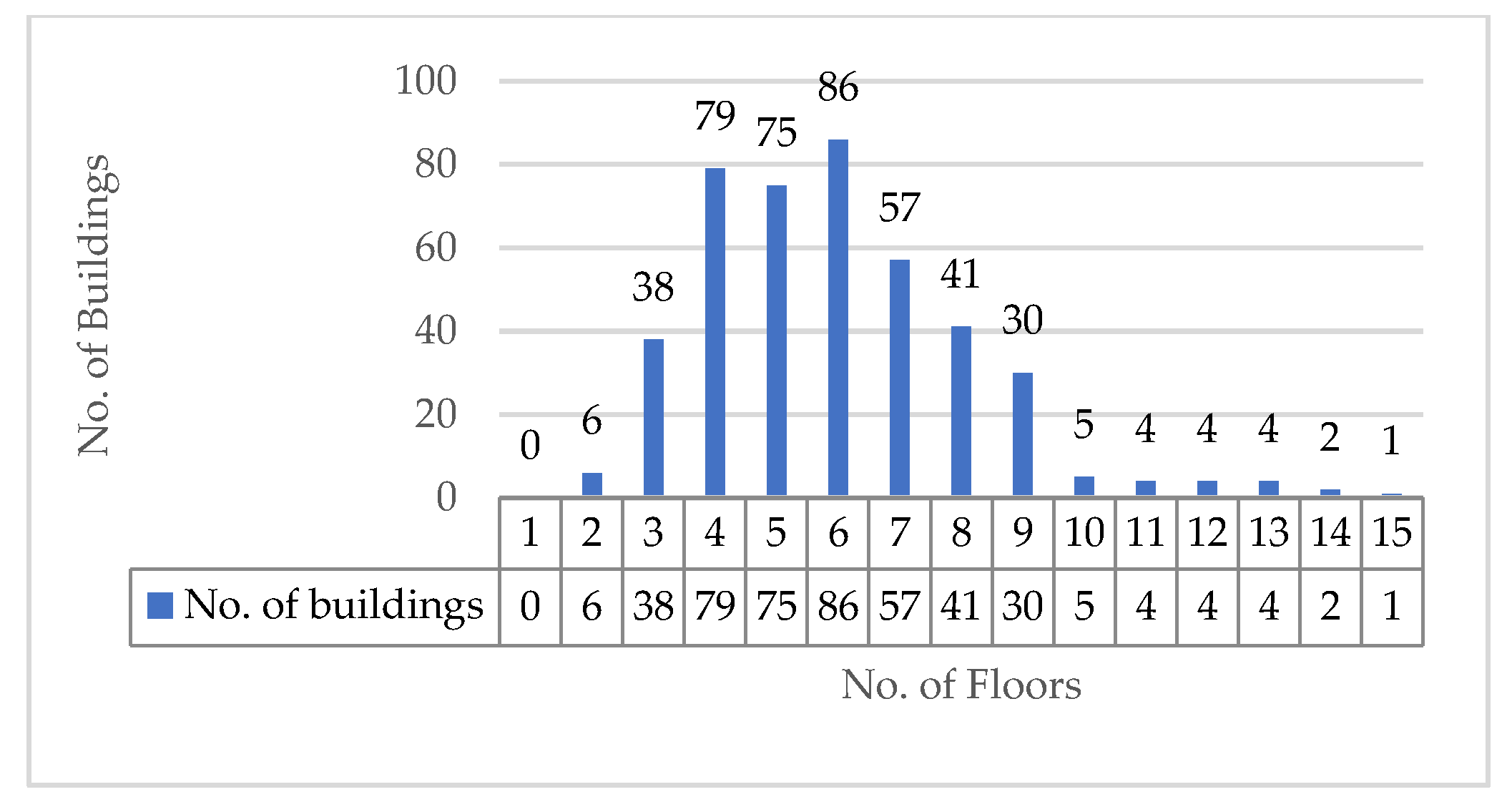
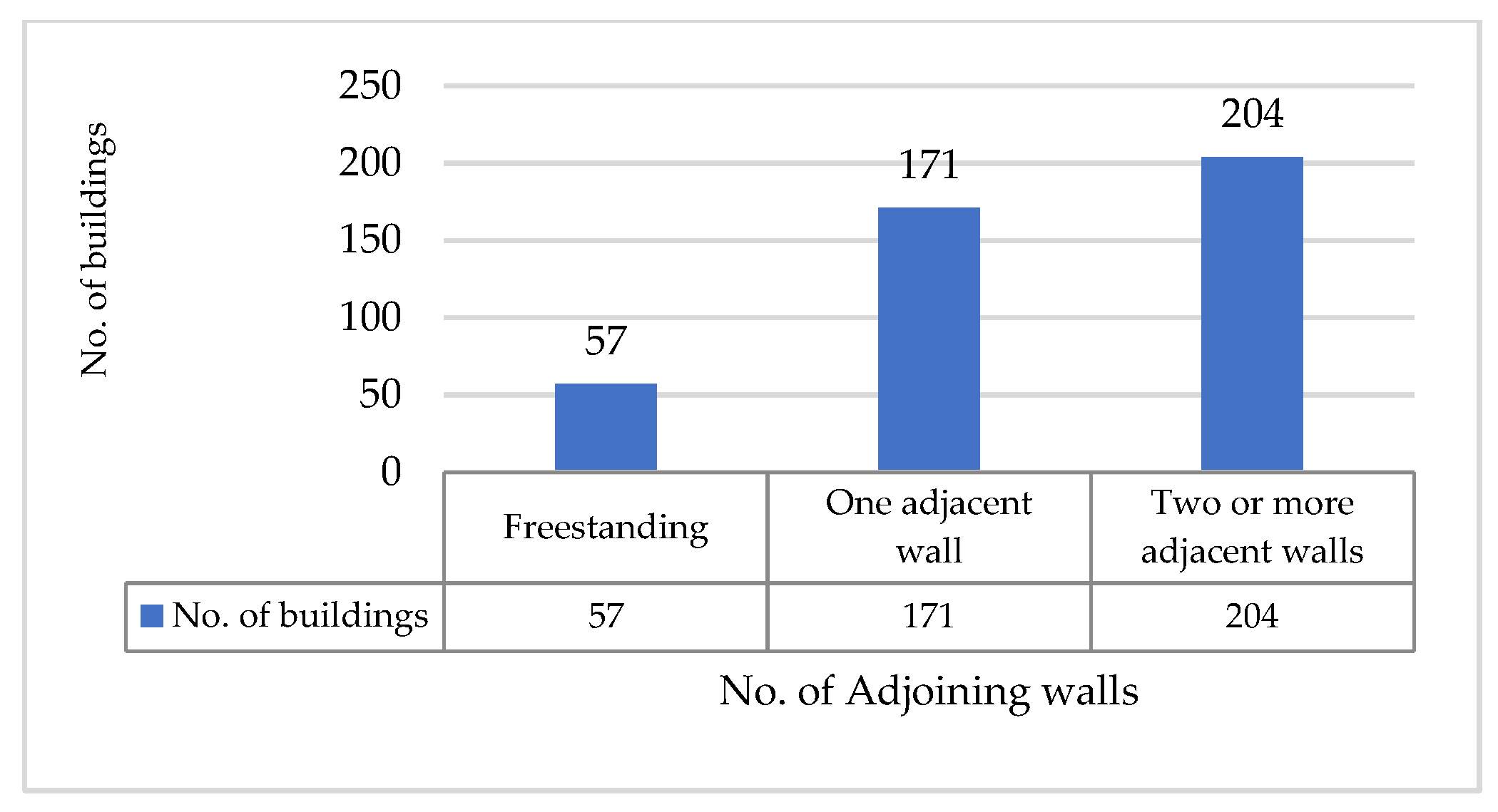
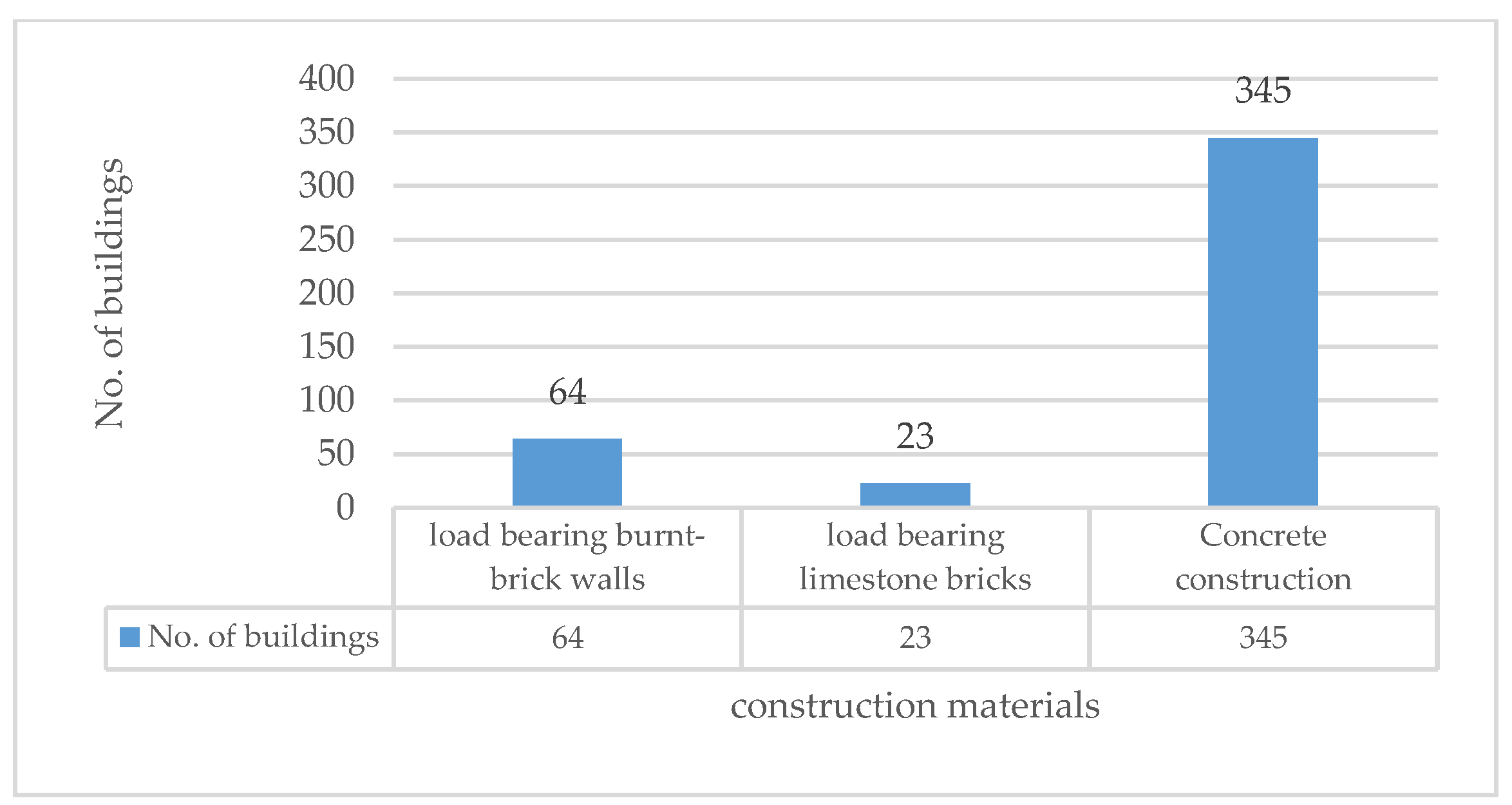

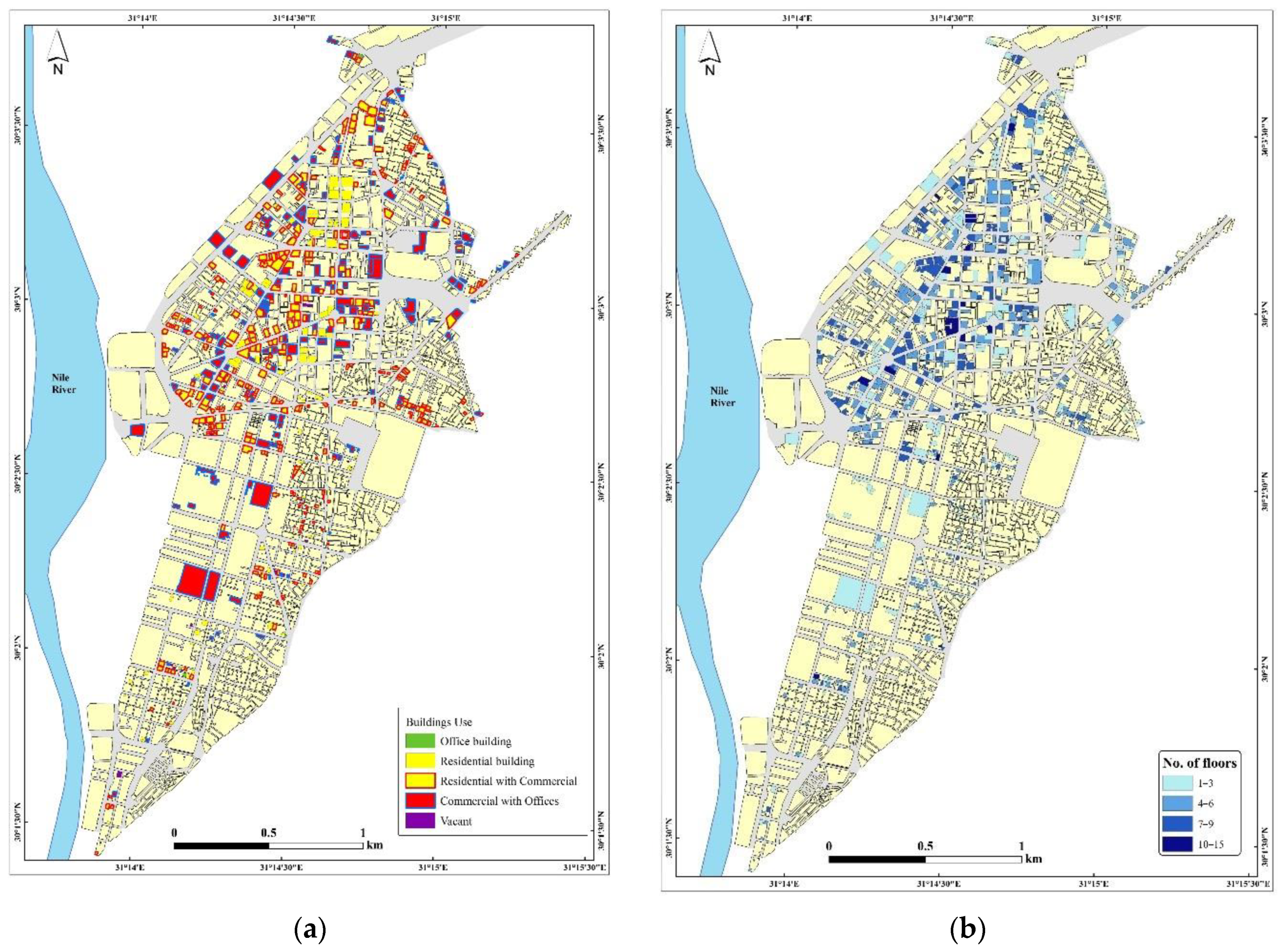
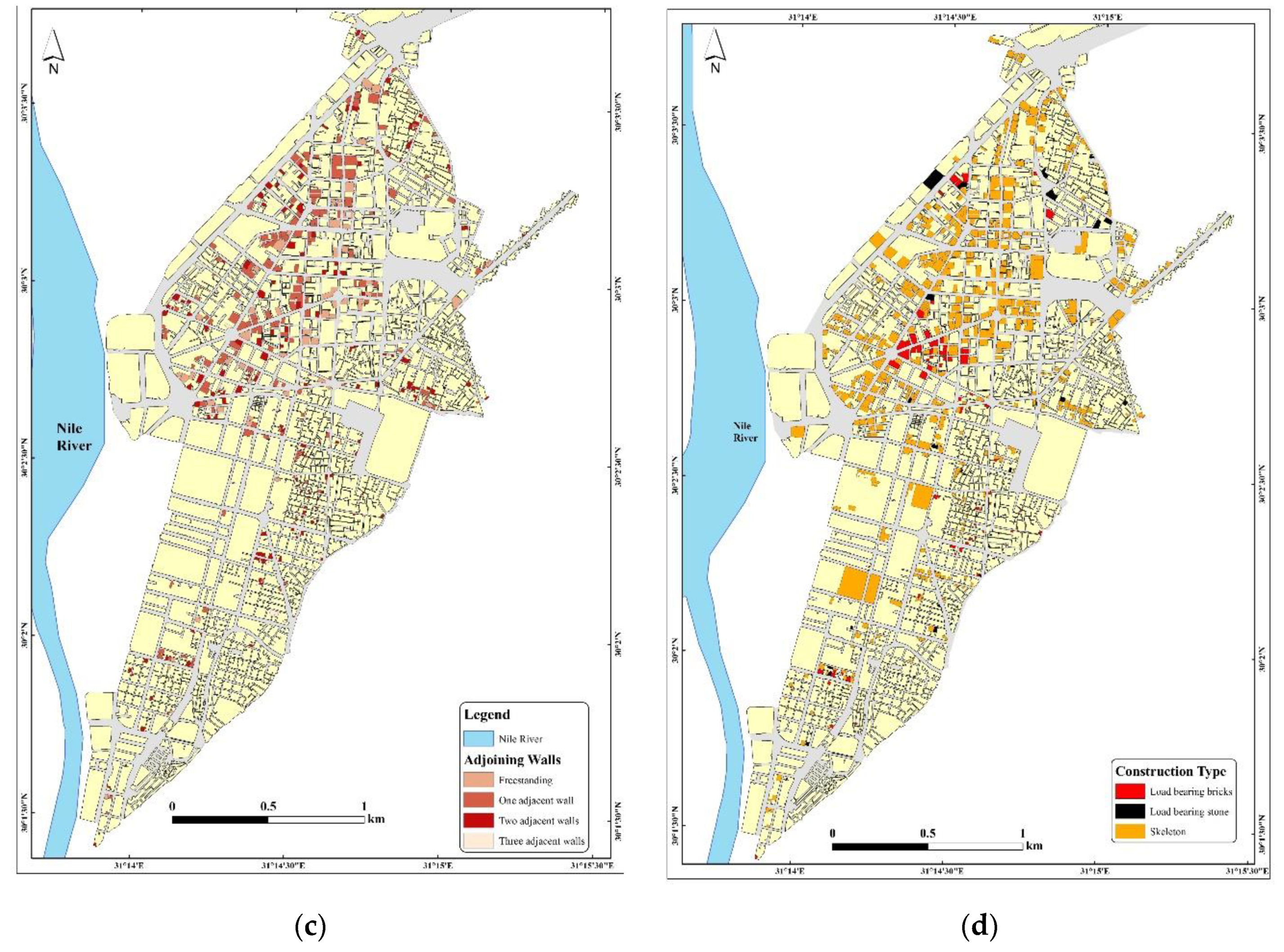
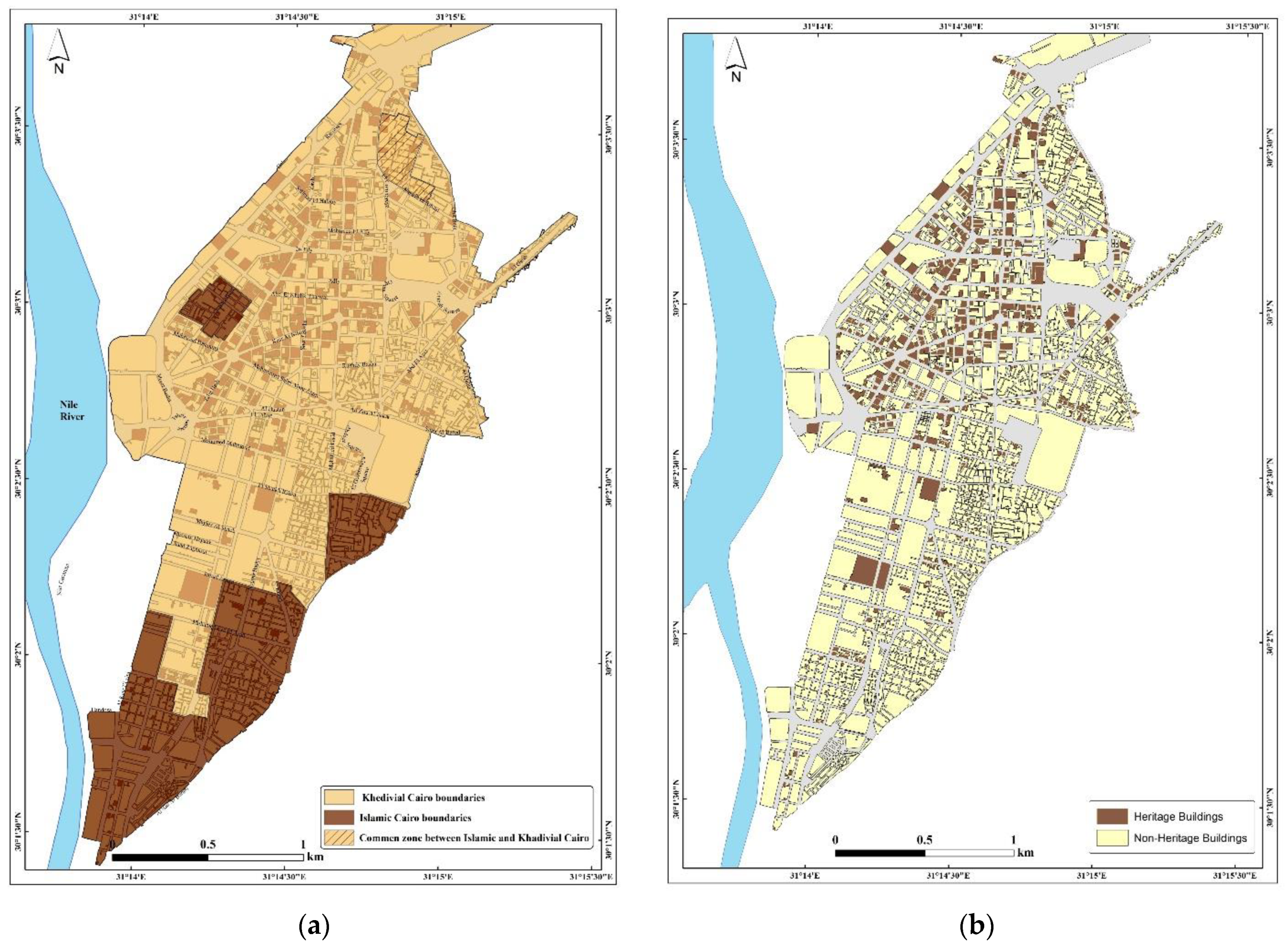
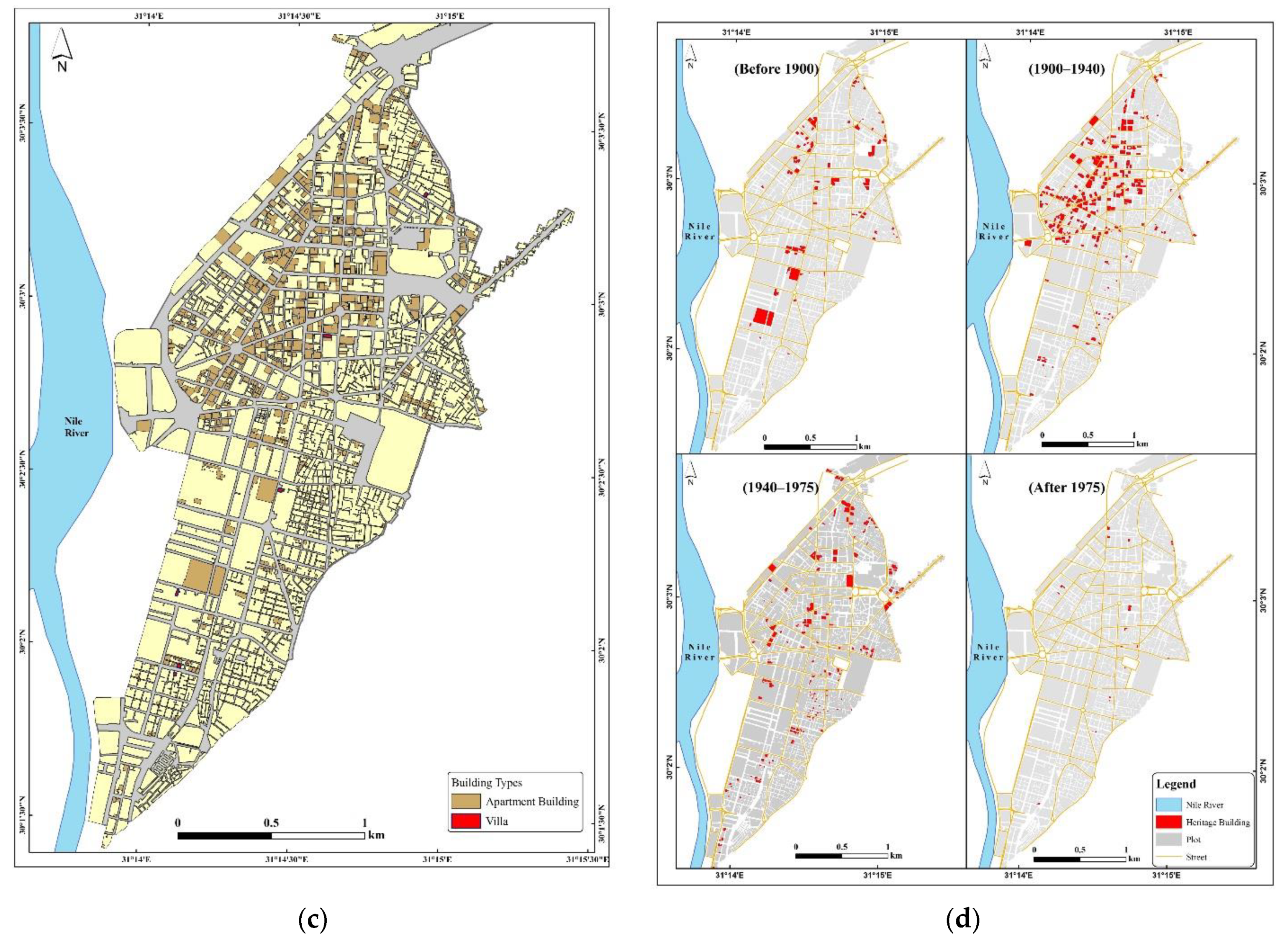
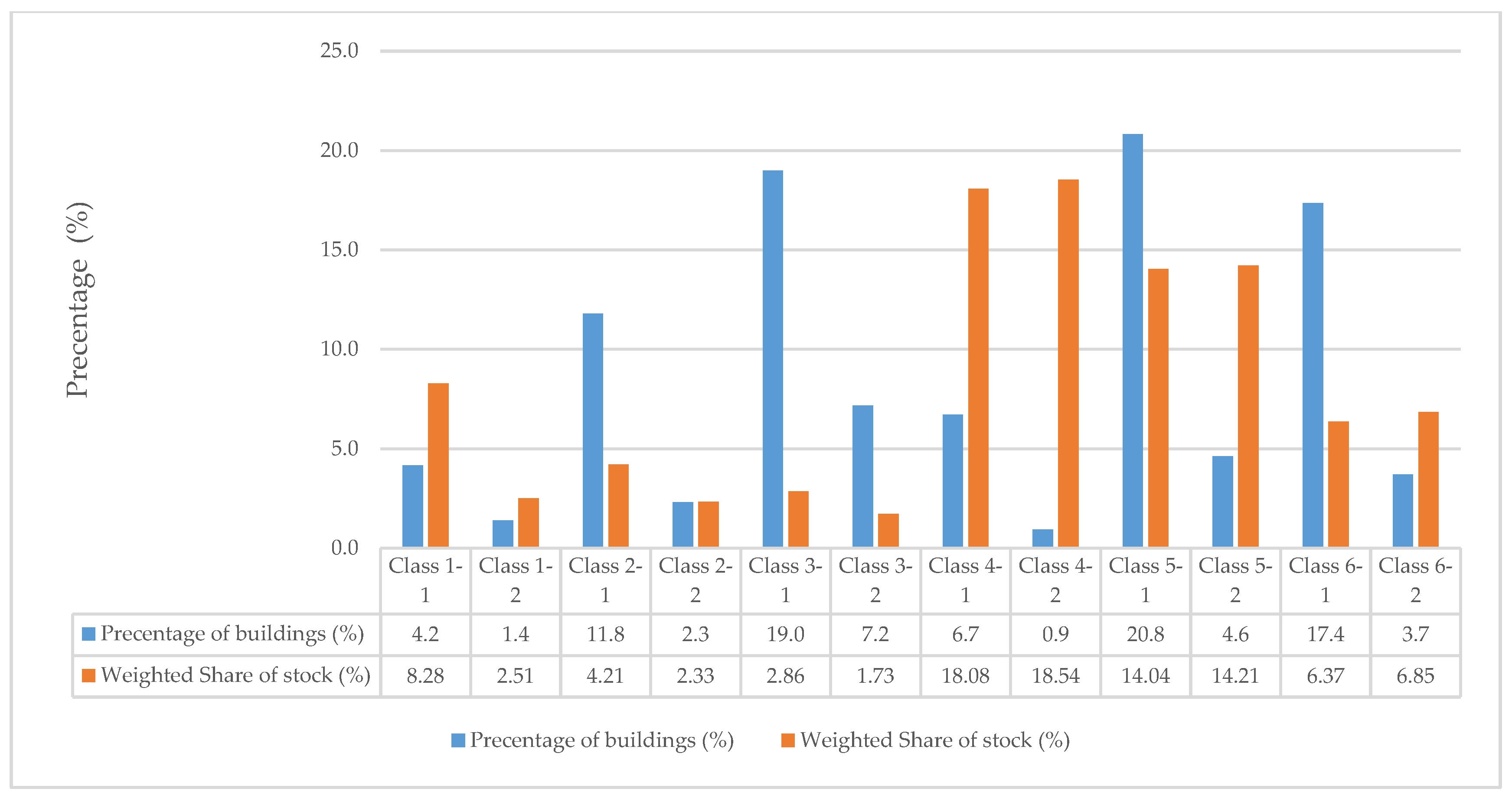
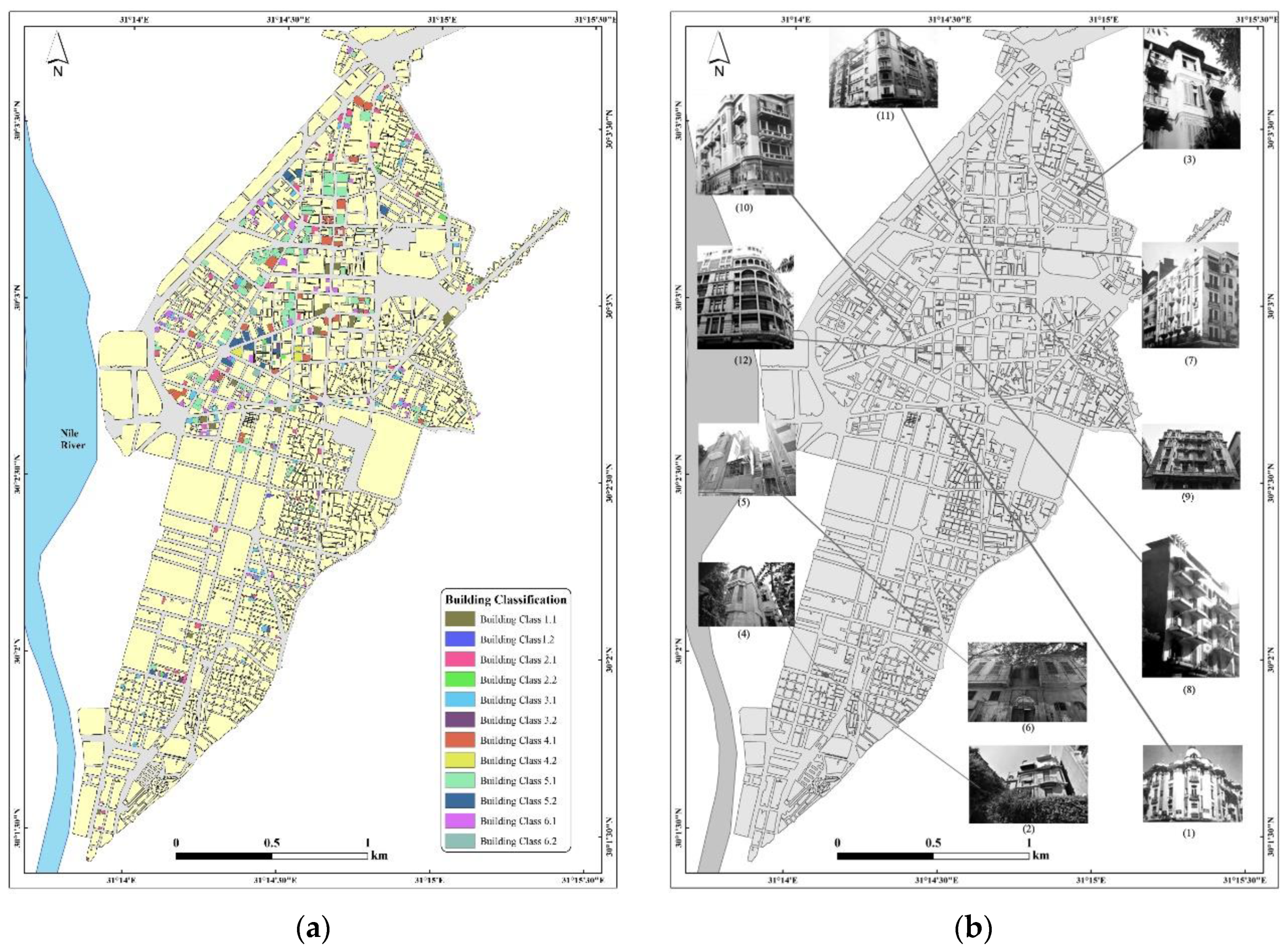


| Type | Group 1 | Group 2 |
|---|---|---|
| No. of floors | 1–5 | 6–15 |
| No. of buildings | 198 | 234 |
| Percentage (%) | 45.8% | 54.2% |
| Criteria | Group 1 (1–5 Floors) | Group 2 (6–15 Floors) | ||||
|---|---|---|---|---|---|---|
| Adjoining walls | Freestanding | One adjacent wall | Two or more adjacent walls | Freestanding | One adjacent wall | Two or more adjacent walls |
| No. of buildings | 24 | 61 | 113 | 33 | 110 | 91 |
| Percentage (%) | 5.6% | 14.1% | 26.2% | 7.6% | 25.5% | 21.1% |
| Classification without Delimitation of the Total Buildings 432 | |||||||||||||
|---|---|---|---|---|---|---|---|---|---|---|---|---|---|
| Criteria | Class 1 | Class 2 | Class 3 | Class 4 | Class 5 | Class 6 | Total | ||||||
| No. of floors | From 1 to 5 | From 1 to 5 | From 1 to 5 | From 6 to 15 | From 6 to 15 | From 6 to 15 | |||||||
| Adjoining walls | Freestanding | One adjacent wall | Two or 3 adjacent walls | Freestanding | One adjacent wall | Two or 3 adjacent walls | |||||||
| No. of buildings | 24 | 61 | 113 | 33 | 110 | 91 | |||||||
| Percentage (%) | 5.6 | 14.1 | 26.2 | 7.6 | 25.5 | 21.1 | |||||||
| Mean area (m2) | 802.20 | 450.17 | 278.59 | 1117.38 | 841.12 | 383.88 | |||||||
| Mean volume (m3) | 12,024.2 | 7443.2 | 4563.0 | 33,829.3 | 25,492.2 | 11,695.5 | |||||||
| Weighted Share of stock (%) | 13 | 8 | 5 | 36 | 27 | 12 | |||||||
| Cl. 1-1 | Cl. 1-2 | Cl. 2-1 | Cl. 2-2 | Cl. 3-1 | Cl. 3-2 | Cl. 4-1 | Cl. 4-2 | Cl. 5-1 | Cl. 5-2 | Cl. 6-1 | Cl. 6-2 | ||
| Construction material types | T1 | T2 or 3 | T1 | T2 or 3 | T1 | T2 or 3 | T1 | T2 or 3 | T1 | T2 or 3 | T1 | T2 or 3 | |
| No. of buildings | 18 | 6 | 51 | 10 | 82 | 31 | 29 | 4 | 90 | 20 | 75 | 16 | 432 |
| Percentage (%) | 4.2 | 1.4 | 11.8 | 2.3 | 19.0 | 7.2 | 6.7 | 0.9 | 20.8 | 4.6 | 17.4 | 3.7 | 100% |
| Weighted share of stock (%) | 8.28 | 2.51 | 4.21 | 2.33 | 2.86 | 1.73 | 18.08 | 18.54 | 14.04 | 14.21 | 6.37 | 6.85 | |
| Residential | 5 | 3 | 14 | 0 | 29 | 16 | 8 | 2 | 15 | 3 | 6 | 3 | 104 |
| Residential + others | 13 | 3 | 37 | 10 | 53 | 15 | 21 | 2 | 75 | 17 | 69 | 13 | 328 |
| Mean area (m2) | 963.52 | 318.21 | 466.10 | 368.88 | 307.94 | 200.94 | 1092.62 | 1296.79 | 838.98 | 850.72 | 376.20 | 419.87 | |
| Mean volume (m3) | 14,999.12 | 4554.97 | 7624.1 | 4213.0 | 5174.1 | 3130.33 | 32,749.74 | 33,589.38 | 25,434.3 | 25,752.7 | 11,545.0 | 12,401.0 | |
| Heritage Value Locations | Elements | The Limits of the Interventions Allowed in Each Heritage Grade | ||||||||
|---|---|---|---|---|---|---|---|---|---|---|
| Grade A | Grade B | Grade C | ||||||||
| Visual | Physical | Spatial | Visual | Physical | Spatial | Visual | Physical | Spatial | ||
| Urban district | Streetscape | P | P | P | P | P | P | P | P | P |
| Roofscape | P | P | P | P | P | P | P | P | P | |
| Building exterior | Finishes | P | P | P | P | R or C | P | R or C | C | R or C |
| External walls | Insulation | NA | NA | NA | A * | A * | A * | A | A | A |
| Decoration | P | P | P | P | R | P | P | R or C | P | |
| Roof | Finishes | R | R | R | R | R or C | R | R or C | C | R or C |
| Insulation | A ** | A ** | A ** | A | A | A | A | A | A | |
| Decoration | P | P | P | P | R | P | P | R or C | P | |
| Parapet | P | P | P | R | R or C | R | R or C | C | R or C | |
| Windows | Glazing | P | R | P | R | R or C | R | R or C | C | R or C |
| Frame | P | R | P | R | R or C | R | R or C | C | R or C | |
| Joints | P | R | P | R | R or C | R | R or C | C | R or C | |
| Shading | P | R | P | R | R or C | R | R or C | C | R or C | |
| Doors | Frame | P | R | P | R | R or C | R | R or C | C | R or C |
| Finishes | P | R | P | R | R or C | R | R or C | C | R or C | |
| Glazing/Wooden | P | R | P | R | R or C | R | R or C | C | R or C | |
| Balconies | Finishes | P | R | P | R | R or C | R | R or C | C | R or C |
| Decoration | P | P | P | P | R | P | P | R or C | P | |
| Handrail | P | P | P | R | R or C | R | R or C | C | R or C | |
| Shops | Glazing | P | R | P | R | R or C | R | R or C | C | R or C |
| Frame | P | R | P | R | R or C | R | R or C | C | R or C | |
| Signs | P | R | P | R | R or C | R | R or C | C | R or C | |
| Building interior | Finishes | P | R | P | R | R or C | R | R or C | C | R or C |
| Internal walls | Decoration | P | P | P | P | R | P | P | R or C | P |
| Finishes | P | R | P | R | R or C | R | R or C | C | R or C | |
| Ceiling | Finishes | P | R | P | R | R or C | R | R or C | C | R or C |
| Decoration | P | P | P | P | R | P | P | R or C | P | |
| Glazing | P | R | P | R | R or C | R | R or C | C | R or C | |
| Windows | Frame | P | R | P | R | R or C | R | R or C | C | R or C |
| Joints | P | R | P | R | R or C | R | R or C | C | R or C | |
| Frame | P | R | P | R | R or C | R | R or C | C | R or C | |
| Doors | Finishes | P | R | P | R | R or C | R | R or C | C | R or C |
| Glazing/Wooden | P | R | P | R | R or C | R | R or C | C | R or C | |
| Heritage Value Locations | Elements | Heritage Value Types | ||
|---|---|---|---|---|
| Visual | Physical | Spatial (Layout) | ||
| Urban district | Streetscape | Preserved | Preserved | Preserved |
| Roofscape | Preserved | Preserved | Preserved | |
| Building exterior | Finishes | Retrofitted | Retrofitted | Retrofitted |
| External walls | Insulation | Not Added | ||
| Decoration | Preserved | Retrofitted | Preserved | |
| Roof | Finishes | Retrofitted | Changed | Retrofitted |
| Insulation | Added | |||
| Decoration | Preserved | Retrofitted | Preserved | |
| Parapet | Retrofitted | Retrofitted | Retrofitted | |
| Windows | Glazing | Retrofitted | Changed | Retrofitted |
| Frame | Retrofitted | Changed | Retrofitted | |
| Joints | Retrofitted | Changed | Retrofitted | |
| Shading | Retrofitted | Changed | Retrofitted | |
| Doors | Frame | Retrofitted | Changed | Retrofitted |
| Finishes | Retrofitted | Changed | Retrofitted | |
| Glazing/wooden | Retrofitted | Changed | Retrofitted | |
| Balconies | Finishes | Retrofitted | Retrofitted | Retrofitted |
| Decoration | Preserved | Retrofitted | Preserved | |
| Handrail | Retrofitted | Retrofitted | Retrofitted | |
| Shops | Glazing | Retrofitted | Changed | Retrofitted |
| Frame | Retrofitted | Changed | Retrofitted | |
| Signs | Retrofitted | Changed | Retrofitted | |
| Building interior | Finishes | Retrofitted | Changed | Retrofitted |
| Internal walls | Decoration | Preserved | Retrofitted | Preserved |
| Finishes | Retrofitted | Changed | Retrofitted | |
| Insulation | Added | |||
| Ceiling | Finishes | Retrofitted | Changed | Retrofitted |
| Decoration | Preserved | Retrofitted | Preserved | |
| Glazing | Retrofitted | Changed | Retrofitted | |
| Windows | Frame | Retrofitted | Changed | Retrofitted |
| Joints | Retrofitted | Changed | Retrofitted | |
| Frame | Retrofitted | Changed | Retrofitted | |
| Doors | Finishes | Retrofitted | Changed | Retrofitted |
| Glazing/wooden | Retrofitted | Changed | Retrofitted | |
| Reference | Cl. | Address | Age | Construction | No. of Apartments | Heritage | Type | No. of Floors | Length (m) | Area (m2) | Volume (m3) | S/V (%) | Retrofitting Scenarios |
|---|---|---|---|---|---|---|---|---|---|---|---|---|---|
| 1 | 1.1 | 25 Al Bustan St. | 1921–1930 | Concrete construction system | 15 | B | Apartment building | 4 | 112.82 | 773.21 | 14,227.1 | 0.00793 | See Table 4 |
| 2 | 1.2 | 13 Ismail Pasha Serry St. | 1900–1910 | Burnt-brick walls | 5 | B | Single family (villa) | 4 | 81.78 | 419.21 | 6707.43 | 0.012193 | See Table 4 |
| 3 | 2.1 | 42 Naguib El Rihani St. | Before 1900 | Concrete construction system | 22 | B | Single family (villa) | 5 | 79.54 | 367.45 | 7349.126 | 0.010824 | See Table 4 |
| 4 | 2.2 | 15 Ismail Pasha Serry St. | 1900–1910 | Limestone brick walls | 3 | B | Apartment building | 3 | 75.41 | 315.42 | 3785.10 | 0.019924 | See Table 4 |
| 5 | 3.1 | 10 Wahbi St. | 1900–1910 | Concrete construction system | 18 | B | Apartment building | 4 | 115.40 | 374.18 | 5238.61 | 0.02203 | See Table 4 |
| 6 | 3.2 | 8 Wahbi St. | 1900–1910 | Limestone Bricks | 9 | B | Apartment building | 3 | 97.36 | 339.23 | 3053.10 | 0.031889 | See Table 4 |
| 7 | 4.1 | 13July 26 st | 1900–1940 | Concrete construction system | 53 | B | Apartment building | 9 | 127.77 | 1031.85 | 32,610.34 | 0.003918 | See Table 4 |
| 8 | 4.2 | 15 Sherif Pasha St. | Before 1900 | Burnt-brick walls | 22 | B | Apartment building | 7 | 135.04 | 380.77 | 31,058.67 | 0.004348 | See Table 4 |
| 9 | 5.1 | 45 Abdel Khalek Sarwat St. | 1900–1940 | Concrete construction system | 12 | B | Apartment building | 7 | 119.51 | 800.5 | 22,393.75 | 0.005337 | See Table 4 |
| 10 | 5.2 | 1 Bahler Pass-Shaldjian St. | 1900–1940 | Burnt-brick walls | 36 | A | Apartment building | 9 | 107.28 | 697.74 | 25,118.85 | 0.004271 | See Table 4 |
| 11 | 6.1 | 18 Adly St. | 1900–1940 | Concrete construction system | 14 | B | Apartment building | 8 | 76.39 | 364.67 | 11,669.68 | 0.006547 | See Table 4 |
| 12 | 6.2 | 3 Bin Taalab St. | 1928 | Burnt-brick walls | 26 | B | Apartment building | 7 | 91.40 | 497.68 | 13,935.04 | 0.006559 | See Table 4 |
Publisher’s Note: MDPI stays neutral with regard to jurisdictional claims in published maps and institutional affiliations. |
© 2021 by the authors. Licensee MDPI, Basel, Switzerland. This article is an open access article distributed under the terms and conditions of the Creative Commons Attribution (CC BY) license (http://creativecommons.org/licenses/by/4.0/).
Share and Cite
Ibrahim, H.S.S.; Khan, A.Z.; Attia, S.; Serag, Y. Classification of Heritage Residential Building Stock and Defining Sustainable Retrofitting Scenarios in Khedivial Cairo. Sustainability 2021, 13, 880. https://doi.org/10.3390/su13020880
Ibrahim HSS, Khan AZ, Attia S, Serag Y. Classification of Heritage Residential Building Stock and Defining Sustainable Retrofitting Scenarios in Khedivial Cairo. Sustainability. 2021; 13(2):880. https://doi.org/10.3390/su13020880
Chicago/Turabian StyleIbrahim, Hanan S.S., Ahmed Z. Khan, Shady Attia, and Yehya Serag. 2021. "Classification of Heritage Residential Building Stock and Defining Sustainable Retrofitting Scenarios in Khedivial Cairo" Sustainability 13, no. 2: 880. https://doi.org/10.3390/su13020880
APA StyleIbrahim, H. S. S., Khan, A. Z., Attia, S., & Serag, Y. (2021). Classification of Heritage Residential Building Stock and Defining Sustainable Retrofitting Scenarios in Khedivial Cairo. Sustainability, 13(2), 880. https://doi.org/10.3390/su13020880







